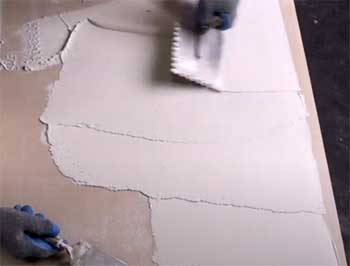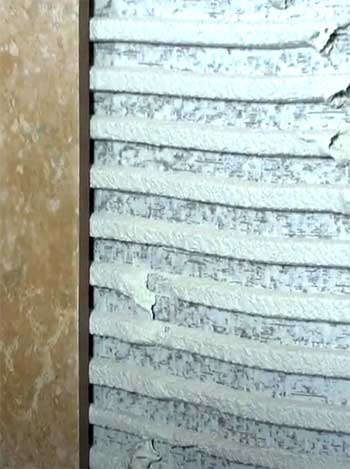Premium Mortar is a no-mess, premixed alternative to thin-set mortars that require water and mixing. It’s non-combustible and ready to use.
But are you having Mapei Premium Mortar not drying issues like many other people out there? Whether the problem is about Mapei Premium or any kind of mortar keep reading, we got you covered!
In this article, we are going to discuss the possible reasons for this problem and the solutions.
How Mortar Dries
Mortar is a mixture of cement, fine sands, and latex polymers. When mortar is mixed with water, a chemical reaction called hydration occurs. The cement particles absorb the water and form rigid crystalline structures that bind the mixture together into a solid mass.
As the water reacts with the cement, the mortar begins to cure and harden. The initial set takes place rather quickly, in anywhere from 2 to 8 hours. This is when the mixture starts to become firm to the touch. But full drying and maximum strength take much longer – generally between 28 to 30 days.
Mortar needs the proper water ratio, temperature, and humidity levels to dry correctly. Too much or too little water, high temperatures that dry it too quickly, or high humidity slowing down evaporation of moisture can all prevent proper curing.
Knowing the ideal conditions for drying gives you clues on environmental factors that may be interfering with your mortar drying correctly. But there are also some specific reasons why premium mortars like Mapei can fail to cure fully.
Possible Reasons Why Mapei Premium Is Mortar Not Drying

- Humidity That Is Too High
Excessive humidity and moisture can directly impact the curing period of the concrete within the mortar.
If you reside in a tropical climate or in an area with significant humidity, Mapei will take longer to cure than the 72-hour maximum curing period suggested by most manufacturers.
- Grout Joint Dimensions
Because the grout joint is one of the ways Mapei mortar receives air to cure the cement, if you’re dealing with ceramic tile rather than natural stone, a smaller grout joint can have a direct impact on the tile installation’s drying time.
Larger joints will mend more rapidly, whereas tight joints will cure in less than 72 hours on average.
- Time Ahead of Grouting
The amount of time it takes to dry depends on the ambient temperature, humidity, and the amount of moisture in the mortar when it’s applied.
Before grouting, the mortar must cure for at least 24 to 48 hours.
When the temperature outside is between 50 and 100 degrees Fahrenheit, use mortar. For at least 72 hours after application, the room temperature should not exceed that range.
The space should be properly ventilated yet not exposed to excessive heat or wind.
- Type Tiles Matters
Man-made tiles, such as those constructed of ceramic or porcelain, are not porous by nature. Travertine, marble, granite, and slate are examples of natural stones.
Because of this, ceramic tiles naturally take longer to cure than real stone equivalents.
Ceramic tile installations, instead of curing via the face of the stone, the grout joints, and the underlayment, can only cure through the joints and the slab or underlayment, which takes longer.
- Curing Vs. Setting
Cement-based goods must be allowed to set, or dry before they can be utilized. These products must also cure, which usually takes place while they are drying.
Curing refers to the hardening of a product through chemical processes within it. Curing begins as soon as the water is added to the dry mortar and continues until it is entirely dry.
The mortar must retain some moisture in order to cure properly.
- Failing to Mix Thoroughly
It’s essential to combine mortar powder and water into a smooth, consistent blend without lumps or dry pockets. But when rushed, it’s easy to end up with partially unmixed sections that won’t cure evenly.
Be sure to mix for a full 3 to 5 minutes after adding powder to water, and don’t add more water part way through mixing to rehydrate dried sections. Scraping down sides and the bottom ensures everything incorporates evenly. Thorough mixing is vital for proper hydration.
- Cold Temperatures
Just like high humidity, cold conditions can drastically slow down mortar curing times. Chemical hydration and evaporation both happen much more slowly when temperatures drop. This causes unset mortar problems when tile is laid in cold weather or drafty indoor spots.
Ideally, mortar should be setting at minimum temperatures between 50-60°F. Once temperatures fall below 50°F, expect drying times to increase significantly. Some premium mortars like Mapei contain additives to improve cold weather performance, but they still could take days longer to dry if it’s too chilly.
If you want to set tile in cold conditions, use room heaters, fans, and dehumidifiers around the installation areas to bring the temperature as close to 60°F as possible. You can use insulated tarps and heat blankets to trap warmth over freshly tiled spots. Just don’t dry the mortar too fast, or that causes problems too.
- Dry Time Accelerators
Some tilesetters try to use rapid-set additives or anti-freeze products to accelerate mortar drying at cold temperatures. Products designed for concrete or concrete repairs may seem similar, but they contain compounds that prevent proper curing of mortar.
For instance, calcium chloride salt mixtures that speed concrete drying will weaken mortars, causing lack of adhesion and cracking later on. Unless the accelerator label specifically says it’s intended for ceramic tile mortars, don’t take the risk. Stick with room heating for cold weather installations.
- Wrong Subfloor Material
What you spread tile mortar onto makes a big difference in drying performance. Certain subfloor materials interact poorly with cement-based adhesives, impeding curing.
For example, applying mortar directly over wood or metal causes them to draw excess moisture out of the thinset prematurely. Concrete has high alkalinity that can interfere with proper crystallization as well.
What Can You Do!

Mapei Premium Mortar can be used for a number of things, including tile underlayment, concrete repairs, and ornamental surfaces.
It comes in the form of a powder that you combine with water to activate the bonding substance, which is often Portland cement.
As the mixture dries, it shrinks and hardens. The mortar is less prone to fracture if it dries slowly, but you may speed up the process if you need it to cure faster to avoid damage.
This can be accomplished by hastening the evaporation of the water.
Things To Know
There are a number of reasons why mortar does not ignite as quickly as it should. It can take three days if the plastersiser has a retartder, especially if everything is moist and wet.
If the joints are exposed to cold, they will expand somewhat and become powdery. Simply drive a nail into the joint to test how deep the frost has penetrated; if it is less than 20mm, scrape it out and repoint it.
Too much fairy liquid will damage the cement, as will rewetting and reworking the mortar when it dries up.
Another major issue is sand; certain sands are fairly lifeless and take a long time to solidify, but they do. Some sands need more cement than others; for example, sharp-washed sand necessitates far less cement than soft dead sand. clearly.
It’s better if you finish all of your jobs before going home in the evening.
Proper Way Of Applying The Mortar

When mixing the mortar, use less water. A stiffer mixture may be more difficult to work with, but it will dry faster.
Apply the mortar on a clean, dry surface. Any moisture that collects beneath the mortar will seep into the mixture, slowing the drying process.
Use a room heater to warm the surrounding area, or direct the heat toward the mortar.
The evaporation rate of the water in the mixture will be increased if the temperature is kept higher than the surrounding environment.
If you notice evidence of cracking in the mortar, lower the heat.
Use a fan to circulate air around the mortar and keep the area aired to enhance air movement. This will have the same impact as heat on the rate of evaporation.
Place a dehumidifier in the space if you have a significant amount of mortar in a closed space to eliminate moisture from the air.
Use a polymer-enhanced quick-setting mortar. It may be used as a tile and stonework underlayment and builds up hard enough for foot traffic in about six hours.
Handling Mortar in the Right Way
When handling and mixing mortar, always follow the manufacturer’s instructions and use a mask, chemical-resistant gloves, and eye protection.
When emptying the dry product out of the bag, be cautious not to inhale the fine powder.
All cement-based products have the potential to irritate or burn the skin. Overexposure can irritate the skin and make it more sensitive.
Remember to phone the technical support lines for the manufacturer of your setting materials; they’ve done a lot of testing on their goods and can provide you with ideas and recommendations to aid you with your installation.
Frequently Asked Questions (FAQ)
There are several possible reasons mortar may not be drying properly:
1. Too much water was added when mixing
2. High ambient humidity is preventing drying
3. Cold temperatures are slowing the curing
4. Using incompatible accelerators or admixtures
5. Too rapid water loss from dry/windy conditions
6. Mixing with incompatible tiles or subfloor materials
7. Failing to mix thoroughly or evenly
8. Applying the mortar too thickly
Under ideal conditions around 72°F and 50% humidity, Mapei premium mortars reach an initial set in 2-4 hours. However, full cure for maximum strength takes 28 days or longer.
The main reasons mortar would not be hardening properly include:
1. Excess water used during mixing
2. Temperatures too cold for proper curing
3. Very high humidity preventing evaporation
4. Adding too much latex or powder admix
5. Incomplete, uneven mixing
Yes, Mapei premium mortars are formulated as thin-set adhesives. They are applied in thin layers, typically 1/4″ to 3/8″ thickness, between the tiles and substrate. This differs from thick bed mortar that is applied in layers over 1/2″ thick.
Final Words
It can be a frustrating situation when you are having a problem with Mapei Premium Mortar that is not drying. We understand you and that is we have tried to find out the reasons and fixes for your problem.
We hope this article has helped you to understand your problem better and the action that is necessary to take to fix this problem. If you still facing a problem, please feel free to drop your issue in the comment box.
